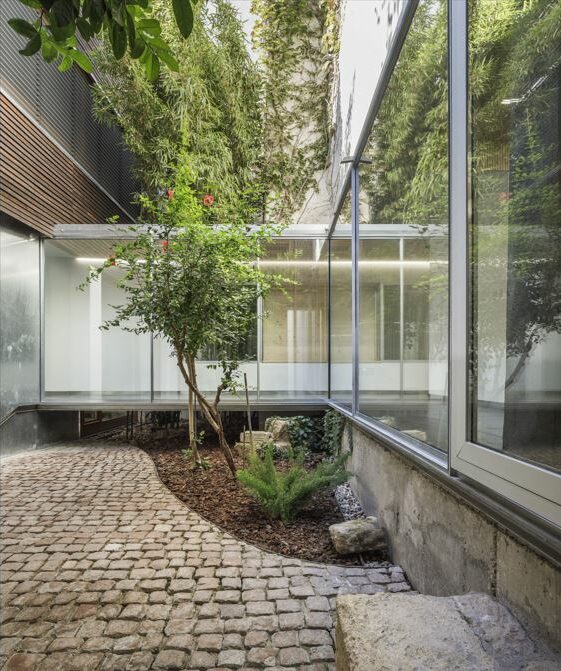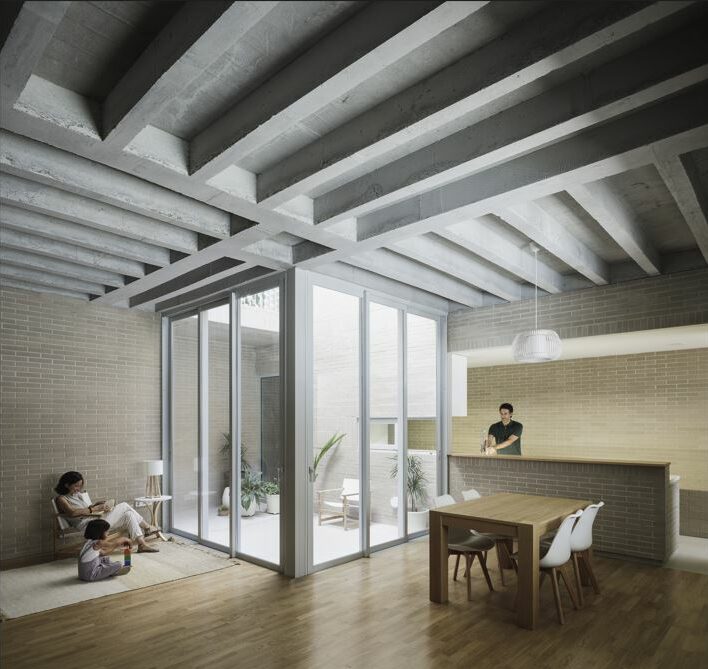María González and Juanjo López de la Cruz, two architects trained at the Seville School of Architecture, founded the SOL89 studio. Their approach focuses on exploring intermediate urban spaces and reusing structures.

Illustration 1: María González and Juanjo López de la Cruz. Photo by Óscar Romero.
Their talent has not gone unnoticed. Accordingly they have notched up an impressive list of awards. These include the First Prize for Architecture from the Architects’ Associations of Seville and Huelva on numerous occasions. They have been awarded the Habitat Prize from the CSCAE‘s Arquitecture Awards 2023 and they are not short of international accolades either. As such, they won Silver Medal at the Fassa Bortolo awards in Italy, and the Austrian First Wiener Berger Prize. Not to mention the Philippe Rotthier First Grand Prix Européen d’architecture in Belgium.

Illustration 2: Arquitectura Awards 2023 Habitat Prize
As authors, they have made a significant contribution to architectural literature with books such as ‘Proyectos Encontrados’ and ‘El Dibujo del Mundo’. Recently, their influence has transcended borders, winning international competitions in South Korea. In addition, they were chosen to take part in the Spanish Biennal in 2014 and 2016 and were awarded a prize in 2022. Furthermore, they were part of the team that won the Golden Lion for the Spanish Pavilion.
At The Decorative Surfaces we have taken a close look at the careers of María González and Juanjo López de la Cruz. Consequently, we were able to explore their inspiring journey in depth, and discover their exciting architectural approach.
In your projects, the close relationship between architecture and the natural environment really stands out. How do you approach integrating your designs into the surrounding landscape?
For us, both the landscape and built environment are part of the same notion of context. We try to explore this notion in order to extract elements that allow the project to interact with its surroundings. Sometimes this interaction happens through integration because after the work everything seems to fit together. In other cases there may be more friction because the project may reveal contextual aspects that are worth highlighting. A good project is not necessarily one that respects the context, but one that highlights a quality that is specific to that place.

Illustration 3: Office within a block. Photo by Fernando Alda.
One of the pillars of the SOL89 studio is to experiment. Could you share a project in which you applied innovative approaches and how did it influence the final result?
Rather than the idea of ‘innovation’, we feel more comfortable with the dual direction of continuity and change of a discipline like architecture. Architecture has basically remained the same since the beginning of mankind. A Roman villa is not so different from a contemporary house with a courtyard. However, as architecture is a product of its time, we could say that all architecture differs at every moment in history. This paradoxical quality of architecture sets it apart from other art forms. The needs of human beings are essentially the same. Yet our way of life continues to evolve and architecture changes with it. Our designs always try to keep in mind this condition of continuity with the past. At the same time we try to understand present needs and to see the directions we are moving towards. Any of our projects, from House 10×10, House of the Nine Porticos, or House with Two and a Half Patios, provide constructive solutions. These are spatial and functional solutions that are contemporary. However, essentially, they are a castle, a barn and a Sevillian courtyard house.

Illustration 4: House 10×10 Photo by Fernando Alda.
You have published several books exploring your architectural work, could you tell us about some of your most outstanding books and what key aspects you address in them?
Writing comes less naturally to us than drawing. But, when we are able do it calmly, it helps us to organise our ideas. The books and texts we have written are the result of our work in the studio combined with research and learning. We have addressed ways of working on pre-existing spaces that are not necessarily heritage buildings (Proyectos encontrados, Recolectores Urbanos 2012). Architects that we feel close to us such as Sverre Fehn (El dibujo del mundo, Lampreave 2014). Or texts on the architecture of intermediate spaces. Or the studios of our generation in Spain that reveal the presence of architecture with communal concerns that define the peninsula.
How do you select the materials and how do they influence the aesthetics and spatial experience?
We identify with those architects who try to have a clear relationship with materials. These are expressed directly, without overly sophisticated construction details or finishes that excessively alter their original nature. We try to provide a tangible and tectonic reading of the space. Not rhetorical, but rather expressing its constructive meaning. We could say that geometry brings an abstract order to space and construction qualifies this abstraction, bringing it closer to sensory perception.
Your designs clearly show a concern for sustainability. Can you share some specific strategies you use to minimise the environmental impact of your projects?
We try to ensure our projects are built with materials extracted or produced close to the construction site. In an effort to establish a link with the local building customs, where these exist. Minimising energy required for transport. Unfortunately, in many places generic materials have become the most easily-accessible option for building. We also try to ensure that the architecture we produce is built with simple solutions. Resources typical of traditional southern buildings, which naturally insulate the constructions, using very basic solutions such as cross ventilation, correct orientation and casting shadows.
You have received numerous awards and accolades for your work. Could you share how this recognition has influenced the evolution of your approach and your professional development?
Awards and accolades are incentives that help us to continue with the working approach that we have chosen from the start. They are also a responsibility because we feel obliged to live up to them. Similarly, it is much like being professors at the Seville School of Architecture. We also like to compare our work on platforms that extend beyond the local sphere. Thus, we confirm the extent to which our ideas can establish a dialogue with other things being done on the national or international scene. This is why we are interested in awards with prestigious juries behind them. In any case, this has nothing to do with our day-to-day work, which is a matter of concentration and precision. Far removed from the impact that our ideas may produce.
In your projects, you balance aesthetics and functionality. How do you address this convergence and what is your approach to achieving a successful balance?
It’s clear to us that architecture is a public service. Therefore, ideas about resolving functional demands and making best use of available resources are always key to our projects. From this point on, we trust that the process will bring more unsuspected questions. Questions of a spatial, constructive or geometric nature. Sometimes they arise from our own interests. At other times, they arise more randomly, ultimately, providing an intense and specific perceptive and realistic experience.
Could you talk about your creative process and how you approach the conception of a new architectural project from the initial idea to its materialisation?
We start every project with two conversations. One is with the clients or future inhabitants. Here we try, not to address the most obvious issues, but rather elements that are difficult to capture in a building use plan. And another that we have with each other when we begin to untangle the mess that projects seem to be at the beginning. Both conversations usually involve a pencil and a roll of paper that unfurls as the first ideas take shape. That is when the concerns we have at that point in our architectural career often converge with the specific issues of the project. So we try to reach a specific response that is coloured by our generic interests. We also make sure that the city, the structure and the construction are at the forefront from the very first steps.
Some of your projects have become architectural landmarks. Could you highlight some of them and share what makes them special and relevant in today’s architectural landscape?
We don’t know if we can speak in terms of landmarks: But having committed to projects for public facilities or heritage intervention, we were very happy to complete one series of houses. Which, from the same point of departure, family housing, has allowed us to try out extremely diverse and specific solutions. At the other end of the spectrum, we are very excited about the three projects we are developing in South Korea. Two of these are already under construction.
Finally, what goals and challenges have you set yourselves for the future?
We would like to continue with a limited size studio that allows us to be present in all phases of the process. From conversation with the client to construction. At the same time we are able to work with various scales, from small projects to larger scale public spaces or facilities. We aspire not to specialise and to continue providing tailored solutions for each project. That way, we begin to draw them without knowing how they will end up.
The Sol89 architecture studio stands out for its innovative approach, both nationally and internationally. However, what makes this interview even more special is the news that María González and Juanjo López de la Cruz will play a key role as curators in the upcoming 16th Spanish Architecture and Urbanism Biennial (BEAU). This commitment to promoting and celebrating contemporary architecture is a testament to their passion and dedication to their discipline.

